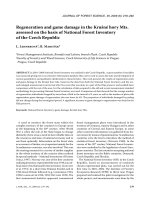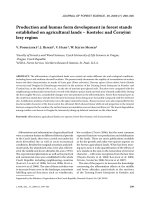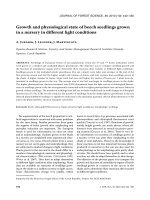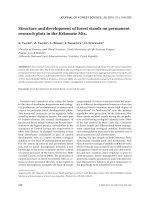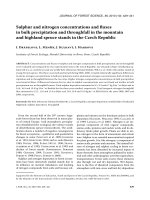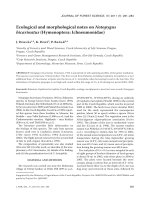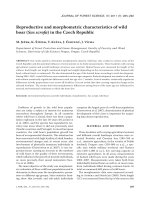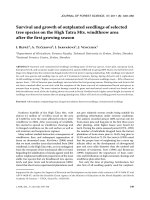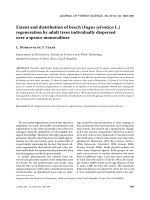Báo cáo lâm nghiệp: "C and 15 N isotopic fractionation in trees, soils and fungi in a natural forest stand and a Norway spruce plantation" pps
Bạn đang xem bản rút gọn của tài liệu. Xem và tải ngay bản đầy đủ của tài liệu tại đây (548.45 KB, 11 trang )
Ann. For. Sci. 64 (2007) 419–429 Available online at:
c
INRA, EDP Sciences, 2007 www.afs-journal.org
DOI: 10.1051/forest:2007019
Original article
13
Cand
15
N isotopic fractionation in trees, soils and fungi in a natural
fo rest stand and a Norway spruce plantation*
Bernd Z
a
**
, Claude B
b
, Jean-Paul M
c
, François L T
d
a
UR1139 Biogéochimie des Écosystèmes Forestiers, Centre INRA de Nancy, 54790 Champenoux, France
b
UMR 1137 INRA-Nancy/Université Henri Poincaré Écologie et Écophysiologie Forestière, Centre INRA de Nancy, 54790 Champenoux, France
c
Groupe mycologique Vosgien, 18 bis, place des Cordeliers, 88300 Neufchâteau, France
d
UMR 1136 INRA-Nancy/Université Henri Poincaré Interactions Arbres Micro-Organismes, Centre INRA de Nancy, 54790 Champenoux, France
(Received 3 August 2006; accepted 18 January 2007)
Abstract –
15
Nand
13
C natural abundances of foliage, branches, trunks, litter, soil, fungal sporophores, mycorrhizas and mycelium were determined
in two forest stands, a natural forest and a Norway spruce plantation, to obtain some insights into the role of the functional diversity of saprotrophic
and ectomycorrhizal fungi in carbon and nitrogen cycles. Almost all saprotrophic fungi sporophores were enriched in
13
C relative to their substrate.
In contrast, they exhibited no or very little shift of δ
15
N. Judging from the amount of C discrimination, ectomycorrhizal fungi seem to acquire carbon
from their host or from dead organic matter. Some ectomycorrhizal species seem able to acquire nitrogen from dead organic matter and could be able
to transfer it to their host without nitrogen fractionation, while others supply their host with
15
N-depleted nitrogen. Moreover ectomycorrhizal species
displayed a significant N fractionation during sporophore differentiation, while saprotrophic fungi did not.
13
C /
15
N / forest stands / sapr otrophic fungi / ectomycorrhizal fungi
Résumé – Fractionnement isotopique 13C et 15N dans les arbres, le sol et les champignons pour un peuplement de forêt naturelle et une
plantation d’épicéas. Les abondances naturelles du
15
Netdu
13
C de la masse foliaire, des branches, des troncs, de la litière, du sol, des carpophores,
des mycorhizes et du mycélium, ont été déterminées dans deux peuplements forestiers, une forêt naturelle et une plantation d’épicéas, afin d’obtenir
quelques précisions sur le rôle de la diversité fonctionnelle des champignons saprophytes et ectomycorhiziens dans le cycle du carbone et de l’azote.
Presque tous les champignons saprophytes présentent un enrichissement en
13
C relativement à leur substrat. Par contre, ils ne présentent pas ou ne
présentent que très peu de modifications du δ
15
N. En fonction de leur taux de discrimination du carbone, les champignons ectomycorhiziens semblent
pouvoir acquérir du carbone à la fois à partir de leur hôte et de la matière organique morte. Quelques espèces semblent capables d’acquérir de l’azote
organique du sol et de le transférer sans fractionnement à leur hôte alors que d’autres fournissent leur hôte en azote appauvri en
15
N. De plus, les
espèces ectomycorhiziennes présentent un fractionnement significatif de l’azote pendant la différenciation des carpophores, alors que les champignons
saprophytes n’en présentent pas.
13C / 15N / peuplements forestiers / champignons saprophytes / champignons mycorhiziens
1. INTRODUCTION
In forest ecosystems, litter and wood breakdown is cru-
cial for nutrient cycling, especially for nitrogen. Saprotrophic
fungi (SF) play a central role in this cycling. They are the
most important decomposers of organic matter, from which
they gain their energy besides other important nutrients [52].
Ectomycorrhizal fungi (EMF) are essential to the health and
growth of forest trees [54]. They can benefit forest trees in a
number of ways, although the most important is the enhance-
ment of nutrient absorption from soil [21]. For organic mat-
ter breakdown, nutrient cycling and energy remobilisation, the
interactions between saprotrophic and ectomycorrhizal fungi
are complex [45]. The general assumption that saprotrophic
* Supplementary data are available online at www.afs-journal.org
** Corresponding author:
fungi would do the mineralization alone and that the ectomy-
corrhizal fungi would take up the mineral elements resulting
from this process is a simplistic view. The ‘Gadgil effect’ is a
good example of the interaction complexity between both fun-
gal groups. In New Zealand, in field and laboratory conditions,
when ectomycorrhizas were excluded from Pinus radiata lit-
ter, the rate of litter decomposition increased over a 12-month
period [15,16]. Several explanations have been proposed for
the ‘Gadgil effect’. It was attributed to stimulated colonization
and exploitation of litter by EMF at the expense of litter SF due
to direct inhibition of SF by EMF. Although ectomycorrhizal
fungi are able to break down litter organic matter, exploita-
tion of litter by EMF in preference to SF would therefore re-
sult in reduced rates of litter decomposition [7]. It was shown
that litter moisture content was also reduced as ectomycorrhiza
density increased [43]. Moisture content is a key determinant
of forest litter decomposition, affecting the size, composition
Article published by EDP Sciences and available at or />420 B. Zeller et al.
and activities of saprotrophic communities [53]. These inter-
actions must be further complicated by the considerable func-
tional diversity that exists between different species of EMF
and SF [5]. Direct competition between ectomycorrhizal and
saprotrophic fungi for nitrogen has also been implicated in the
‘Gadgil effect’.
The importance of ectomycorrhizas for nitrogen nutrition
was recognized at an early stage [50]. Mineral nitrogen lev-
els in the soil solution represent a low percentage of nitrogen
potentially available for uptake. It is likely that the uptake of
nitrogen largely occurs through EM fungi, as their extraradi-
cal hyphae commonly make up most of the nutrient absorp-
tion surface of the tree [55]. Ammonium often is the dominant
form of inorganicN in forest soils. Ectomycorrhizal fungi have
a preference for NH
+
4
and there is considerable variability in
their ability to utilize NO
−
3
[49]. In the view of many authors,
inorganic N absorbed into hyphae is assimilated and translo-
cated as amides and amino acids in the fungus, probably uti-
lizing metabolic pathways that are different from those of the
host plant [6,10,14,47,48]. It has been shown that some ecto-
mycorrhizas can produce proteolytic enzymes, which release
and take up N from various peptides [1, 2] and this may con-
tribute to direct cycling of N through forest floor litter [51].
It is clear that EMF have a potential to mineralize and also
directly gain resources from complex organic soil fractions.
However, the quantitative significance of direct N or C cy-
cling by ectomycorrhizal fungi in the field is not very well
known. Stable isotope techniques are efficient tools for eco-
physiology and ecosystem research [25, 35, 37].
13
Cand
15
N natural abundance and
14
C measurements have been used
to study fungal sources of carbon and nitrogen [28]. Gebauer
and Dietrich [17] found that sporophores of ectomycorrhizal
fungi were more enriched in
15
N than other ecosystem com-
ponents including sporophores of saprotrophic fungi. Högberg
et al. [36] showed that ectomycorrhizas of Norway spruce
and beech collected across Europe were 2% more enriched
in
15
N than non-mycorrhizal fine roots. Fungal sheaths were
2.4−6.4% enriched relative to the root core. Other studies
have confirmed that sporophores of ectomycorrhizal fungi
were often enriched in
15
N relative to sporophores of sapro-
phytic fungi, whereas sporophores of saprotrophic fungi were
almost all the time enriched in
13
C relative to sporophores of
ectomycorrhizal fungi [23,26,27,41,55–57]. Taylor et al. [56]
shown that isotopes signatures of sporophores varied by
family, genus and species. Lilleskov et al. [44] showed a corre-
lation between isotope signatures and possible ecophysiologi-
cal functions. Ectomycorrhizal fungal species that utilized or-
ganic nitrogen in laboratory cultures exhibited higher natural
abundance of δ
15
N than did fungal species that utilized only
inorganic forms of nitrogen. Emmerton et al. [12] used only
fungi to show that there was fractionation of N isotopes upon
uptake. However, the concentration of the inorganic N com-
pounds in the experiment was much higher than that found in
nature. These laboratory results, therefore, cannot be extrapo-
lated to the natural situation.
Although the relative contribution of the C and N sources
and the different internal processes involved in the frac-
tionation of
13
Cand
15
N remain unclear, it appears that
the analysis of natural abundances of carbon and nitro-
gen isotopes could provide an insight into the respec-
tive trophic role of saprotrophic versus ectomycorrhizal
fungi [18,26–28, 31–34,37,38].
The purpose of this work was to investigate the ways of ni-
trogen and carbon acquisition by both fungal types in a natural
mixed forest stand and a Norway spruce plantation, situated
in the centre of France, by using
13
Cand
15
N natural abun-
dance. The aims of this work were (i) to determine whether
13
Cand
15
N natural abundance could differentiate the ecolog-
ical groups of Basidiomycetes present at the two sites, (ii) to
determine whether ectomycorrhizal fungi were able to acquire
carbon from dead organic matter in addition to the carbon pro-
vided by their host, (iii) to determine the possible role of hosts
in carbon and nitrogen acquisition by ectomycorrhizal fungi,
(iv) to determine whether the processes involved in mycor-
rhizal functioning and sporophore differentiation could partly
explain differences in N fractionation generally observed be-
tween ectomycorrhizal and saprotrophic fungi.
2. MATERIAL AND METHODS
2.1. Field sampling
Substrates (foliage, fine branches and wood), soil samples and
fungal sporophores were collected in October 2001 and in October
2002 in the state forest of Breuil-Chenue, Nièvre, France in two
stands:
– a natural forest stand of beech (Fagus sylvatica L., 90% of the
stems), oak (Quercus sessiliflora Smith, 5% of the stems) and birch
(Betula verrucosa Ehrh., 5% of the stems);
– a Norway spruce (Picea abi es (L.) Karst.) stand planted in 1976
after clearfelling of a natural forest stand.
The experimental site of Breuil-Chenue forest is situated in the
Morvan Mountains, Burgundy, France (latitude 47
◦
18’ 10”, lon-
gitude 4
◦
4’ 44”). The elevation is 640 m, the annual rainfall
1280 mm, the evapotranspiration 640 mm and the mean annual tem-
perature 9
◦
C. The parent rock is granite, containing 23.5% quartz,
44% K feldspath, 28.5% plagioclase, 1.6% biotite and 1.6% mus-
covite. The soil is an alocrisol, with a pH ranging between 4 and
4.5 [3]. The humus is a dysmoder with three layers (L, F and H) [39].
The nitrogen deposition rate is 15 kg N ha
−1
y
−1
(Ranger, personal
communication). The Norway spruce plantation was not fertilized.
Mature fungal sporophores were collected in October 2001 in
the natural forest stand and in October 2002 in the Norway spruce
plantation. Traditional mycological identification methods were used
for taxonomic determination. The different species were classified
into ecological groups according to the literature (accepted knowl-
edge of ecological niches) and their niches observed in the collect-
ing site [9, 11]. The saprotrophic fungi (SF) were divided into seven
groups: fungi living on A
I
horizon (ASF), fungi living on decaying
needles (NSF), fungi living on decaying strobiles (SSF), litter decay-
ing fungi living on F and H layers (FHSF), wood decaying fungi liv-
ing on small twigs on the ground (TSF), wood decaying fungi living
on dead branches, stumps or trunks (DWSF) and fungi living on dead
or living wood (DLWSF).
In the natural stand, sporophores of 47 species were collected
at random on a plot of 5000 m
2
in four samples for almost all
species: 33 ectomycorrhizal fungi (EMF) and 14 SF including 1 ASF,
13
Cand
15
N fractionation in saprophytic and ectomycorrhizal fungi 421
Tab le I. Total C, total N, C/N, δ
13
Candδ
15
N in foliage, fine branches and stem wood of beech, oak and Norway spruce, Breuil forest (n = 5,
± SD).
Species Organ C (%) N (%) C/N δ
13
C(%) δ
15
N(%)
Beech Leaves 47.3 2.6 18 –28.5 –4.2
Fine branches 49.0 ± 1.5 1.1 ± 0.1 43 ± 4 –26.9 ± 0.1 –4.2 ± 0.4
Wood 50.8 ± 0.6 0.12 ± 0.02 425 ± 71 –28.1 ± 0.9 –3.5 ± 1.6
Oak Leaves 48.9 2.7 18 –28.6 –4.1
Fine branches 48.7 ± 0.6 1.1 ± 0.2 45 ± 9 –28.8 ± 0.9 –4.8 ± 0.6
Wood 46.3 ± 0.6 0.14 ± 0.09 303 ± 100 –26.4 ± 0.1 –3.7 ± 0.5
Norway spruce Needles 49.0 1.6 31 –27.1 –2.4
Fine branches 47.8 ± 0.5 0.8 ± 0.1 62 ± 5 –25.3 ± 0.8 –3.4 ± 0.3
Wood 47.9 ± 0.5 0.07 ± 0.01 722 ± 69 –24.9 ± 0.9 –3.9 ± 0.6
2 TSF, 3 FHSF, 6 DWSF and 2 DLWSF. Sample sizes (n), were as fol-
lows: EMF n = 106, SF n = 35, ASF n = 3, TSF n = 5, FHSF n = 5,
DWSF n = 16, DLWSF n = 6. Due to the low rainfall during autumn
2001, the saprotrophic fungi were relatively scarce compared to ecto-
mycorrhizal fungi. Leotia lubrica (Scop.: Fr.) Pers. (ASF) was found
on naked soil devoid of litter, generally near beech trunks.
In the Norway spruce plantation, sporophores of 37 species were
collected at random on two plots of 2500 m
2
in four exemplars for
almost all species: 20 ectomycorrhizal fungi (EMF) and 17 SF in-
cluding 1 ASF, 4 TSF, 5 FHSF, 4 DWSF, 2 SSF and 1 NSF. Sam-
ple sizes (n), were as follows: EMF n = 65, SF n = 63, ASF n = 1,
TSF n = 15, FHSF n = 20, DWSF n = 12, DLWSF n = 3, SSF n = 8,
NSF n = 4.
In both stands a total of 71 species were collected. 34 species were
collected only in the natural stand, 24 were collected only in the Nor-
way spruce stand and 13 were collected both in the natural stand and
the Norway spruce stand. A total of 336 samples were collected for
stable isotope analysis. After cleaning, elimination of sporophores
contaminated by worms, drying and grinding, 269 samples were kept
for stable isotope analysis.
Some sporophores were dissected in order to compare stable iso-
tope composition among stipe, cap and gills. Beech fine roots, my-
corrhizas and external ectomycorrhizal mycelium were collected in
October 2002 and washed under a dissecting microscope. External
ectomycorrhizal mycelium of Tricholoma sciodes was cleaned strand
by strand with needles. There were four replicates for each organ or
tissue, except for external mycelium (one replicate due to the dif-
ficulties of collecting). Cortinarius and Lactarius mycorrhizas were
identified at the genus level by morphotyping. T. sciodes mycorrhizas,
mycelium and sporophores were identified using molecular methods.
Stipes and gills of T. sciodes were separately collected.
All samples were first air dried and then dried at 60
◦
C for 48 h.
Except for external mycelium, they were ground to a fine powder
using a shaker with agate mortar and agate beads.
2.2. Isotopic analysis
Whole mature sporophores were analyzed. Whenever possible
several sporophores were included in each sample. Percent C and
N and isotopic composition were determined using an online con-
tinuous flow CN analyser (Carlo Erba NA1500) coupled with an iso-
tope ratio mass spectrometer (Finnigan delta S). Values were reported
in the standard notation (δ
13
C% and δ
15
N%) relative to Pee-Dee
Belemnite for C, using PEF (IAEA-CH-7) as a standard, and relative
to atmospheric N
2
for N, using (NH
4
)
2
SO
4
(IAEA-N-1) as a stan-
dard. δX = (R
sample
/R
standard
)-1) × 1000, where R is the molar ratio
heavy
X/
light
X.
2.3. Statistical analysis
The analysis of variance for the experimental data was conducted
using Sigmastat 3.0 (SPSS Inc., Chicago). Student’s t-tests were em-
ployed to test for significant differences between saprotrophic and
ectomycorrhizal fungi, and One-Way-ANOVA for differences among
the different species.
3. RESULTS
3.1. The C/Nratio,δ
13
Candδ
15
N from the living trees
to the soil (Tabs. I and II)
3.1.1. C/N
The average C/N ratio was 18 in beech and oak leaves
and31inNorwayspruceneedles.TheC/N ratio in fine
branches was similar in beech and oak (43 and 45 respectively)
and higher in Norway spruce (62); in wood the C/N ratios were
303 (oak), 425 (beech) and 722 (Norway spruce).
The C/N ratio in the natural stand was 30 in the L+F layer
and 27 in the H layer. It decreased to 20 in the A horizon and
then remained relatively stable along the first 40 cm. In the
Norway spruce stand, the C/N ratio was higher in the L+F
layer than in the natural stand. The ratios in the two stands
were identical in the 0−5to15−25 cm horizons, but the ratio
at 25−40 cm was lower in the Norway spruce stand than in the
natural stand. The higher C/N value of Norway spruce litter
was a consequence of low total nitrogen content.
3.1.2. δ
13
C
The δ
13
C values were very similar in living beech leaves,
living oak leaves and living Norway spruce needles. The
422 B. Zeller et al.
Table II. Total C, total N, C/N, δ
13
Candδ
15
N in the humus layers (L+F and H horizons) and in the mineral soil at different depths in the
natural stand and in the plantation, Breuil forest (n = 5, ± SD).
Stand Horizon C (%) N (%) C/N δ
13
C(%) δ
15
N(%)
Natural stand L+F 47.4 ± 41.6± 0.2 30 –28.4 ± 0.4 –4.3 ± 1.0
H 37.8 ± 12 1.4 ± 0.1 27 –28.4 ±0.4 –3.5 ± 1.3
0–5 cm (A
1
)6.2± 1.8 0.3 ± 0.1 20 –28.3 ± 0.8 1.4 ± 1.5
5–10 cm (A
2
)5.4± 1.6 0.3 ± 0.06 19 –28.5 ± 0.5 2.9 ± 1.1
10–15 cm 3.3 ± 1.1 0.2 ± 0.07 18 –27.7± 0.9 3.7 ± 0.6
15–25 cm 1.9 ± 0.6 0.1 ± 0.03 21 –27.2 ± 0.8 4.7 ± 0.8
25–40 cm 1.5 ± 0.4 0.1 ± 0.02 19 –27.5 ± 1.3 4.8 ± 0.9
Plantation L+F 49.4 0.9 56 –28.0 –2.7
0–5 cm (A
1
)7.2± 0.5 0.4 ± 0.02 20 –27.1 ± 0.3 0.6 ± 0.1
5–10 cm 3.9 ± 0.5 0.2 ± 0.03 19 –27.0 ± 0.4 2.8 ± 0.4
10–15 cm 2.7 ± 0.4 0.1 ± 0.02 19 –26.8 ± 0.6 2.9 ± 0.6
15–25 cm 2.0 ± 0.1 0.1 ± 0.01 18 –27.3 ± 0.8 4.4 ± 0.6
25–40 cm 0.9 ± 0.2 0.06 ± 0.01 15 –26.7 ± 0.9 5.4 ± 0.4
δ
13
C values of fine branches were more variable: oak
(−28.8%), beech (−26.9%), and Norway spruce (−25.3%).
In living trees, wood δ
13
C ranged from −24.9% (Norway
spruce), −26.4% (oak) to −28.1% (beech).
In soil, δ
13
C varied between −26.8% and −28.4%.Inthe
A
1
and A
2
horizons, soil under Norway spruce displayed a
lower δ
13
C value than soil under the natural stand.
3.1.3. δ
15
N
The average δ
15
N values were identical in living beech and
oak leaves (−4.2% and −4.1% respectively), while lower
in living Norway spruce needles (−2.4%). The δ
15
Nvalues
differed little between beech and oak in fine branches and
wood. In these two species, wood δ
15
N was lower than in fine
branches or leaves. In Norway spruce, δ
15
N increased from
leaves to fine branches and from fine branches to wood. Wood
δ
15
N did not differ among the three species.
In the two stands, compared to the fresh material, there was
no
15
N enrichment of the litter, which still displayed a nega-
tive δ
15
N(−4.3% in the L+F layer of the natural stand and
−2.7% for spruce). Strong
15
N enrichment was observed in
the A
1
horizon of the two stands. In both stands A
1
δ
15
Nbe-
came positive (1.4% in the natural stand and 0.6% in spruce
stand). δ
15
N continued to increase in the soil according to
the depth, without any significant differences between the two
stands. At 25−40 cm depth, δ
15
Naveraged5%.
3.2. Total carbon, total nitrogen, δ
13
Candδ
15
N
of sporophores
The average concentration of total C and total N of
sporophores was, respectively, 45% and 4%. The total nitrogen
concentration ranged from 1.9% to 7% and the carbon con-
centration from 35 to 54%. There were no statistically valid
differences in the total N and C either between saprotrophic
and ectomycorrhizal fungi or between sporophores collected
in both stands (Fig. 1A).
δ
13
Candδ
15
N of sporophores differed significantly be-
tween saprotrophic and ectomycorrhizal fungi (P < 0.001),
although the two groups overlapped both for δ
13
Candδ
15
N.
The δ
13
C of ectomycorrhizal fungi collected in Norway spruce
stand was significantly less negative than δ
13
C of ectomycor-
rhizal fungi collected in natural stand. δ
15
N of saprotrophic
fungi collected in Norway spruce stand was also significantly
more negative than δ
13
C of saprotrophic fungi collected in the
natural stand (Fig. 1B).
3.2.1. Discrimination among saprotrophic fungi through
13
Cand
15
N natural abundance (Fig. 2)
Two sampled fungal species were common to native and
Norway spruce stands: Armillaria gallica and Hypholoma fas-
ciculare. δ
13
Candδ
15
N of these two fungal species did not
differ between the two stands.
Saprotrophic sporophores displayed a variable δ
13
C rang-
ing from −25.6% (Leotia lubrica)to−18.9% (Hygrophorop-
sis aurantiaca). Four groups could be statistically distin-
guished: the ASF group, the NSF group, the SSF, TSF, DWSF
and FHSF group and the DLWSF group. Leotia lubrica (ASF)
slightly modified the δ
13
C of its substrate. In average, its own
δ
13
Cwas−25.7%, while soil organic matter δ
13
C ranged
from −26.0% to −29.5%. Micromphale perforans (NSF)
(average δ
13
C −24.9%) modified a little more the δ
13
Cof
its substrate (−28.0%). A. gallica (DLWF) shifted its δ
13
Cto-
wards −20.0%, possibly indicating a specific carbon fraction-
ation by lignin or cellulose degradation. Between these three
groups, the SSF, TSF, DWSF and FHSF groups displayed a
moderate enrichment in
13
C relatively to the substrate (aver-
age δ
13
C −23.0%).
13
Cand
15
N fractionation in saprophytic and ectomycorrhizal fungi 423
Figure 1. Discrimination among ectomycorrhizal (EMF) and sapro-
trophic (SF) sporophores collected in the natural stand and in the
Norway spruce plantation according to (A) total C and total N, and
(B) δ
13
Candδ
15
N, Breuil forest, (all sporophores, mean and stan-
dard deviation for each group). Ectomycorrhizal and saprotrophic
sporophores did not differ for total N, nor total C, while they dif-
fered for δ
15
N(P < 0.001) and δ
13
C(P < 0.001). Ectomycorrhizal
fungi in natural stand differed from ectomycorrhizal fungi in Norway
spruce plantation for δ
13
C(P < 0.001), while they did not differ for
15
N. Saprotrophic fungi in natural stand differed from saprotrophic
fungi in Norway spruce plantation for
15
N(P < 0.001), while they
did not differ for δ
13
C.
Saprotrophic sporophores had a δ
15
N ranging from −5.2%
to 4.5%. ASF sporophores differed from all the other groups,
displaying an average δ
15
Nof3.0%, while the other groups
displayed an average δ
15
Nof−3.0%.
3.2.2. Discrimination among ectomycorrhizal fungi
through
13
Cand
15
N natural abundance
3.2.2.1. Natural stand (Figs. 3A and 3B)
With the exception of one sample of Cortinarius paleaceus
displaying a δ
13
Cof−20.7%, all sporophores of ectomycor-
rhizal fungi in natural stand had a δ
13
C ranging from −23.0%
Figure 2. Discrimination among saprotrophic sporophores collected
in the natural stand and in the Norway spruce plantation according
to δ
13
Candδ
15
N, Breuil forest, (all sporophores, mean and stan-
dard deviation for each group). (ASF) saprotrophic fungi living on A
I
horizon, (NSF) saprotrophic fungi living on decaying needles, (SSF)
saprotrophic fungi living on decaying strobiles, (FHSF) litter decay-
ing fungi living on F and H layers, (TSF) wood decaying fungi living
on small twigs on the ground, (DWSF) wood decaying fungi living on
dead branches, stumps or trunks and (DLWSF) fungi living on dead
or living wood. NSF, TSF, FHSH and DWSF sporophores did not
differ for δ
13
C nor δ
15
N. DLWSF sporophores statistically differed
from NSF, TSF, FHSH and DWSF sporophores for δ
13
C(P < 0.001).
ASF and NSF sporophores differed from SSF, TSF, FHSH and DWSF
sporophores for δ
13
Candδ
15
N(P < 0.001).
(some species of the genus Lactarius)to−28.6% (one exem-
plar of Tricholoma ustale). δ
15
N ranged from −6.5% (Hy-
grophorus lindtneri) to 12.7% (Cortinarius alboviolaceus)
with an average of 3%.
Several species of the genus Tricholoma were characterized
by a low δ
13
C and a large
15
N enrichment. Several species
of the genera Cortinarius and Hydnum behaved similarly for
15
N, but displayed a low
13
C discrimination. The genera Bo-
letus and Xerocomus behaved similarly with a medium po-
sition among the ectomycorrhizal fungi. The genera Sclero-
derma, Amanita and Cantharellus were relatively close to each
other and displayed homogeneous δ
13
C. The genus Laccaria
was significantly different from all the other genera with a low
15
N discrimination and a large
13
C discrimination.
Within genera, individual species displayed distinct signa-
tures (Figs. 4A, 4B and 4C). Species of the genera Cortinarius
and Russula exhibited large variations in δ
15
N, while species
of the genus Amanita did not.
There were clearly two different types of ectomycorrhizal
fungi displaying small and very large
15
N enrichment, respec-
tively. Between these two types, all the intermediaries could
be observed.
3.2.2.2. Norway spruce plantation (Figs. 3D and 3C)
In the Norway spruce plantation, sporophores of ectomyc-
orrhizal genera differed little in δ
13
Candδ
15
N, except for the
424 B. Zeller et al.
Figure 3. Discrimination among ectomycorrhizal sporophores in the Breuil forest according to δ
13
Candδ
15
N, (A) natural stand, all
sporophores, (B) natural stand, mean and standard deviation for each genus: Ama. = Amanita,Bol.= Boletus,Cant.= Canthar ellus,Cor.=
Cortinarius, Hyd. = Hydnum, Hyg. = Hygrophorus, Lac. = Laccaria, Lact. = Lactarius,Rus.= Russula,Scl.= Scleroderma,Tri.= Tricholoma,
Xer. = Xerocomus,(C) Norway spruce plantation, all sporophores, (D) mean and standard deviation for each genus: Ama. = Amanita,Bol.=
Boletus,Cant.= Cantharellus,Chal.= Chalciporus,Clav.= Clavulina,Cor.= Cortinarius,Gom.= Gomphidus, Lac. = Laccaria, Lact. =
Lactarius,Pax.= Paxillus,Rus.= Russula,Scl.= Scleroderma,Xer.= Xerocomus.
genus Chalciporus, which differed from all others at once by
its δ
13
C and its δ
15
N.
Ectomycorrhizal sporophores displayed a δ
13
C ranging
from −22.2% (Chalciporus piperatus)to−25.5% (Russula
betularum). δ
15
N ranged from −0.6% (Lactarius theiogalus)
to 7.9% (C. piperatus) with an average of 3.0%.
3.2.2.3. Comparison between the two stands (Fig. 5)
Overall, δ
13
C of ectomycorrhizal sporophores differed sig-
nificantly between Norway spruce plantation and natural
stand, while δ
15
N did not (Fig. 5A). All sporophores of ec-
tomycorrhizal species common to both stands displayed a sta-
tistically significant δ
13
C shift, with the exception of Sclero-
derma citrinum (Fig. 5D). Only Lactarius theiogallus and S.
citrinum shifted significantly in δ
15
N between the two stands
(Figs. 5B and 5D).
3.2.2.4. Changes in δ
13
C and δ
15
N from beech fine roots
to mycorrhizas and sporophores of ectomycorrhizal fungi
(Figs. 6A and 6B)
δ
13
Cof Lactarius mycorrhizas significantly differed from
that of beech fine roots whereas Cortinarius mycorrhizas did
not (P < 0.001). δ
15
NofLactarius and Cortinarius myc-
orrhizas significantly differed from δ
15
N of beech fine roots
(P < 0.001) (Fig. 6A).
Similarly, δ
15
NofT. sciodes mycorrhizas significantly dif-
fered from δ
15
N of beech fine roots (Fig. 6B). The external
mycelium of T. sciodes mycorrhizas showed increased δ
15
N
compared to mycorrhizas. But, due to the difficulties of sam-
pling, we had only one replicate. The δ
15
N continued to sig-
nificantly increase from mycorrhizas to sporophore stipes and
from stipes to gills. In contrast, the δ
13
C showed less discrim-
ination between beech fine roots and T. sciodes sporophores
than did the δ
15
N.
4. DISCUSSION AND CONCLUSIONS
In the Breuil forest, as expected, the C/N ratio of Norway
spruce foliage was higher than in beech or oak. This ratio also
was higher in spruce fine branches and wood than in hard-
woods. These differences were reflected in the humus layer.
But in the rest of the soil profile no difference was observed
between the natural stand and the Norway spruce plantation.
Twenty-five years of growth of the spruce were not sufficient
to modify soil macro parameters such as total C, total N or
C/N ratio. Under both stands, the C/N ratio decreased in the
13
Cand
15
N fractionation in saprophytic and ectomycorrhizal fungi 425
Figure 4. Variations in δ
13
Candδ
15
N in sporophores of three ecto-
mycorrhizal genera collected in the natural stand: Cortinarius, Rus-
sula and Amanita, Breuil forest (mean and standard deviation for each
species). C. albo. = Cortinarius alboviolaceus, C. ano. = C. anoma-
lus,C.bol= C. bolaris,C.del.= C. delibutus, C. malic. = C. mal-
icorius, C. sang. = C. sanguineus,C.sub= C. subtortus,C.pal.= C.
paleaceus,R.fel.= Russula fellea, R. frag. = R. fragilis,R.mair= R.
mairei,R.och.= Russula ochr oleuca, R. puel. = R. puellaris,A.cit=
Amanita citrina,A.musc.= A. muscaria,A.rub.= A. rubescens.
A horizon. Presumably, carbon is lost as CO
2
during decom-
position, whereas nitrogen is retained.
δ
15
N of total N increased with soil depth without any signif-
icant difference between the two stands. δ
15
N shifted from −4
to −3% in the litter and from 4 to 5% in the deeper mineral
soil. According to Kendall and McDonnell [40], most soils
have δ
15
N values ranging from 2 to 5%. Hobbie et al. [26]
reported for Glacier Bay a δ
15
Nof0.6% in the organic soil
and 6% in the mineral soil.
The δ
13
C of the total C in the soil showed little change
with depth; the range was −26.8% and −28.4%.Theseval-
ues are similar to those obtained by Hobbie et al. [26] in the
Glacier Bay National Park (Alaska), where the δ
13
C ranged
from −29.7% (Alnus foliage) to −27.5% in organic soil and
−25.6% in mineral soil. In the first 15 cm of the Breuil forest
soil, δ
13
Cdiffered slightly but significantly between the two
stands. After 25 years of plantation growth, the Norway spruce
seems to have increased δ
13
C of soil total C in the upper part
of the profile by about 1%. This may imply that the majority
of the soil carbon in the upper profile has been replaced in the
25 years since Norway spruce was planted.
As reported by several authors [18,23,26,38,41] δ
13
Cval-
ues differ between sporophores of saprotrophic and ectomyc-
orrhizal fungi.
In the Breuil forest, with the exception of Leotia lubrica,
all sporophores of saprotrophic fungi showed
13
C enrichment
relative to their substrate. Isotopic
13
C fractionation during or-
ganic decomposition is not very well known. Cellulose and
lignin degradation could be involved in
13
C enrichment of
sporophores of saprotrophic fungi, although until now no fun-
gal culture studies on known
13
C complex substrates have been
done.
Most saprotrophic fungi had no or little effect on fractiona-
tion of stable N isotopes from their substrates (leaves, twigs or
wood). For example, the δ
15
N of ASF reflected their substrate
(A horizon), which was enriched in
15
N in comparison with
the litter.
The δ
15
Ndifferences observed between saprotrophic
sporophores collected in the natural stand and in the Norway
spruce plantation could be due to the fact that most of sapro-
trophic species analyzed in both stands were not the same.
These differences could be attributed to differences in isotopic
signatures of fungal species.
13
C fractionation by sporophores of ectomycorrhizal fungi
varied within a narrow range according to the genera and
species. For example, Tricholoma species did not fraction-
ate C, while species of Lactarius were enriched in
13
C, less
than the purely saprotrophic fungi however. According to the
rate of C discrimination in their sporophores, it could be as-
sumed that EM fungi acquire carbon either most exclusively
from their host (i.e. Tricholoma) or partially from organic mat-
ter (i.e. Lactarius). This hypothesis is strengthened by the fact
that Lactarius mycorrhizas displayed
13
C fractionation rela-
tive to nonmycorrhizal roots, while Cortinarius mycorrhizas
did not. Handley et al. [19] reported that ectomycorrhizal col-
onization with Hydnangium carneum did not influence δ
13
Cof
Eucalyptus. Hobbie and Colpaert [30] shown that colonization
of Pinus sylvestris by Suillus increased overall system δ
13
C
but not colonization by Thelephora.
Overall, the δ
13
C of ectomycorrhizal sporophores differed
significantly between the Norway spruce and natural stands.
These differences were presumably driven by differences in
the
13
C of recent photosynthates fixed by beech versus Norway
spruce and then transferred to ECM fungi.
N fractionation by sporophores of ectomycorrhizal fungi
was also very variable. For example, Hygrophorum lindtneri
did not fractionate nitrogen. In contrast, the genera Cortinarius
426 B. Zeller et al.
Figure 5. Discrimination among ectomycorrhizal sporophores of 11 species common to natural stand and Norway spruce plantation according
to δ
13
Candδ
15
N, Breuil. (A) all species; (B) Lactarius theiogallus;(C) Boletus edulis,(D) Scleroderma citrinum;(E) Amanita (A. Cit-
rina, A. muscaria, A. rubescens); (F) Russula (R. fellea, R. ochroleuca, R. puellaris); (G) Laccaria amethystina;(H) Xerocomus badius.(all
sporophores). * δ
13
C, differences statistically significant between the natural stand and the plantation (P < 0.01)
#
δ
15
N, differences statistically
significant between the natural stand and the plantation (P < 0.01).
13
Cand
15
N fractionation in saprophytic and ectomycorrhizal fungi 427
Figure 6. (A) Discrimination among beech fine roots, Lactarius and
Cortinarius mycorrhizas according to δ
13
Candδ
15
N (all samples,
mean and standard deviation for each organ). For δ
15
N, Lactarius
mycorrhizas and Cortinarius mycorrhizas were not different but dif-
fered from beech fine roots (P < 0.03 and P < 0.001). For δ
13
C,
Lactarius mycorrhizas statistically differed from beech fine roots and
Cortinarius mycorrhizas (P < 0.001). (B) Discrimination among
beech fine roots, mycorrhizas, external ectomycorrhizal mycelium,
stipe and gills of Tricholoma sciodes according to δ
13
Candδ
15
N(all
samples, mean and standard deviation for each organ or tissue). For
δ
13
C, beech fine roots did not differ from mycorrhizas; mycorrhizas
differed from stipe (P < 0.023) and stipe from gills (P < 0.05). For
δ
15
N, all organs or tissues were statistically different from all others
(P < 0.001). The absence of replicates for external ectomycorrhizal
mycelium did not allow statistical calculation for this tissue.
and Tricholoma displayed a huge nitrogen fractionation. These
results are partly congruent with those of several work-
ers [17,22–24,26,36], who all observed high
15
N abundances
in ectomycorrhizal fungi sporophores. Ammonification usu-
ally causes a small fractionation (+ or – 1%) between soil or-
ganic N and ammonium [37,40]. This small fractionation due
to ammonification cannot explain a shift of 10% or 12%,as
observed in Cortinarius or Tricholoma sporophores. In nitro-
gen limited systems, like the native forest stand, fractionation
by nitrification also is weak. So we can explain
15
N enrich-
ment observed in EMF sporophores neither by ammonification
nor by nitrification. In ammonium volatilization, the gas has a
lower δ
15
N than ammonium remaining in the soil [37, 40]. In
heavily manured farmland, ammonium volatilization may in-
duce a large increase in δ
15
N of the remaining nitrogen. This
process cannot be involved in this natural site. Denitrification,
which occurs in anaerobic conditions, increases the δ
15
Nof
the residual nitrate, but cannot really be involved in this well
drained soil, even if it could occur in the centre of aggregates.
In our study, Lactarius mycorrhizas displayed no signifi-
cant
15
N enrichment relative to beech fine roots, while δ
15
N
of Cortinarius and Tricholoma mycorrhizas differed signifi-
cantly from beech fine roots. δ
15
N changed from −3% (beech
fine roots) to −2% (Cortinarius mycorrhizas) or 0.5% (Tri-
choloma mycorrhizas). δ
15
N changed from 0.5% in Tri-
choloma sciodes mycorrhizas to 4.2% in external mycelium.
This seems to indicate that for some ectomycorrhizal fungi,
enzymatic reactions involved in fungal nitrogen metabolism
and transfer to the host could cause a significant δ
15
N change,
while for other ectomycorrhizal species (Lactarius) no change
was observed. Mariotti et al. [46] found a small discrimina-
tion against
15
N during nitrate uptake by 38 species of plants.
In general, ammonium or nitrate uptake favours
14
N over
15
N [37,40]. Bardin et al. [4] found that δ
15
NinPinus halepen-
sis mycorrhizas was 2% depleted relative to non-mycorrhizal
roots. Handley et al. [19] found no difference in N fraction-
ation between mycorrhizal and non-mycorrhizal roots of Eu-
calyptus globulus. In this study, ECM colonization was rela-
tively low, perhaps accounting for lack of difference between
none and ECM colonized roots. Högberg et al. [36] found
that mycorrhizal roots of Norway spruce and beech were 2%
enriched in
15
N relative to non-mycorrhizal roots. Emmerton
et al. [13] showed that Betula nana seedlings, which were my-
corrhizal with Paxillus involutus, displayed no N fractionation
when supplied with glutamic acid or glycine but did display
significant fractionation against
15
N-ammonium. This ammo-
nium fractionation probably occurred during uptake. However,
it is very likely that the fractionation occurred because of the
quite high concentrations of ammonium available to the myc-
orrhizas. These concentrations are orders of magnitude higher
than those found in natural soils. This line of reasoning, that
fractionation only is found when concentrations are very high,
has resulted in the general assumption acceptance of the pre-
vailing wisdom (whether true or not): fractionation upon up-
take does not occur in N limited systems [29,32–34]. Accord-
ing to Hobbie et al. [26] and Kohzu et al. [42], the transfer of
nitrogen to trees by ectomycorrhizal fungi is a fractionating
process, which could occur through amino acid biosynthesis
or amino acid transfer to the host.
Our results with Tricholoma sciodes also showed that
the differentiation processes which led to sporophore forma-
tion induced a δ
15
N shift. Moreover, inside the sporophores,
the process of gill differentiation caused another δ
15
Nshift.
Handley et al. [20] and Taylor et al. [55] obtained similar
results. They found a higher δ
15
N in fungal caps relative to
stipes. Taylor et al. [55] observed a
15
N enrichment of protein
relative to chitin of about 9% in sporocarps relative to hy-
phae. A preferential export of protein-derived N to sporocarps
428 B. Zeller et al.
and retention of chitin-bound N in mycelium may explain the
15
N enrichment in sporocarps [32].
In conclusion, the differences in
13
Cand
15
N natural abun-
dance observed in the Breuil forest among sporophores of
saprotrophic or ectomycorrhizal fungi is the result of complex
interactions between carbon and nitrogen sources and the dif-
ferent physiological pathways involved in organic matter de-
composition, nitrogen uptake, nitrogen assimilation, nitrogen
transfer to the host and sporophore differentiation. The host it-
self has a role on
13
C fractionation of sporophores of ectomy-
corrhizal fungi. Almost all ectomycorrhizal sporophores com-
mon to both stands displayed a more negative δ
13
C in natural
stand than in Norway spruce plantation. This could result from
an indirect effect of Norway spruce, through soil organic mat-
ter modifications, or from a direct effect of the host, through
carbon transfer processes to the fungi. The fact that there was
no effect of the host on
13
C fractionation of sporophores of
saprotrophic fungi is an argument in favour of this second hy-
pothesis.
Our results also show that there is a continuum in
13
Cand
15
N fractionation between ectomycorrhizal and saprotrophic
fungi. This could mean that some pathways for carbon and
nitrogen acquisition are not different between EMF and SF,
while others differ. Among ectomycorrhizal fungi, there seems
to be two possible ways of carbon acquisition, partial acquisi-
tion from dead organic matter (i.e. Lactarius) and acquisition
from the host (i.e. Tricholoma or Cortinarius). Some ectomy-
corrhizal fungi (Cortinarius or Tricholoma) seem able to ac-
quire nitrogen from the soil, in inorganic or organic forms,
and to supply their host with
15
N-depleted nitrogen. Others
(i.e. Lactarius) seem to have a different way of operating and
either supply N to the host without N isotope fractionation
or do not supply N to the host. These results are congruent
with those of Courty et al. [8], who shown that ectomycor-
rhizas display in situ differential hydrolytic and oxidative en-
zymatic activities involved in the decomposition of lignocellu-
loses, chitin and phosphorus-containing organic compounds.
Moreover Tricholoma species and probably some other ec-
tomycorrhizal species displayed a significant N fractionation
during sporophores differentiation, while saprotrophic fungi
did not.
The analysis of
13
Cand
15
N natural abundance in the
Breuil forest has allowed differentiation of the main ecolog-
ical groups of Basidiomycetes present at this site and pro-
vided a new insight into the respective trophic role of sapro-
trophic versus ectomycorrhizal fungi. The processes involved
in sporophore differentiation partly explain differences in
N fractionation generally observed between ectomycorrhizal
and saprotrophic fungi. Moreover, the host has a significant
effect on δ
13
C of ectomycorrhizal sporophores.
Our objectives were not to investigate the complete nitro-
gen or carbon cycle in the Breuil forest. However, Hobbie and
Hobbie [35] have recently shown that the fractionation against
15
N could be used to quantify carbon and nitrogen fluxes in
different compartments of natural ecosystems.
Acknowledgements: This study was funded by the ECOFOR GIP
contract 1502 A. The research utilized in part the online continuous
flow CN analyser (Carlo Erba NA1500) coupled with an isotope ratio
mass spectrometer (Finnigan Delta S) and DNA sequencing facili-
ties at INRA-Nancy financed by INRA and the Région Lorraine. We
particularly thank Dr. Erik A. Hobbie for greatly improving the paper
with his comments and corrections and the two anonymous reviewers
for helpful suggestions.
REFERENCES
[1] Abuzinadah R.A., Read D.J., The role of proteins in the nitrogen nu-
trition of ectomycorrhizal plants. I. Utilization of peptides and pro-
teins by ectomycorrhizal fungi, New Phytol. 103 (1986) 481−493.
[2] Abuzinadah R.A., Read D.J., The role of proteins in the nitrogen
nutrition of ectomycorrhizal plants. IV. The utilization of peptides
by birch (Betula pendula), New Phytol. 112 (1989) 55−60.
[3] Baize D., Girard M.C. (Eds.), Référentiel pédologique, Éditions
INRA, Paris, 1995.
[4] Bardin R., Domenach A.M., Chalamet A., Rapports isotopiques na-
turels de l’azote. II. Variations d’abondance du
15
N dans les échan-
tillons de sols et de plants; applications, Rev. Écol. Biol. Sol 14
(1977) 395−402.
[5] Bending G.D., Litter decomposition, ectomycorrhizal roots and the
‘Gadgil’ effect, New Phytol. 158 (2003) 228−229.
[6] Chalot M., Brun A., Botton B., Occurrence and distribution of the
fungal NADP-dependent glutamate dehydrogenase in spruce and
beech ectomycorrhizas, in: Werner D., Müller P. (Eds.), Fast grow-
ing trees and nitrogen fixing trees, Gustav Fischer, New York, 1989,
pp. 324−327
[7] Colpaert J.V., van Tichelen K.K., Decomposition, nitrogen and
phosphorus mineralization from beech leaf litter colonized by ec-
tomycorrhizal or litter-decomposing basidiomycetes, New Phytol.
134 (1996) 123−132.
[8] Courty P.E., Pritsch K., Schloter M., Hartmann A., Garbaye J.,
Activity profiling of ectomycorrhiza communities in two forest soils
using multiple enzymatic tests, New Phytol. 167 (2005) 309−319.
[9] Courtecuisse R., Mushrooms of Britain and Europe, Harper Collins,
London, 2000.
[10] Dell B., Botton B., Martin F., Le Tacon F., Glutamate dehydro-
genase in ectomycorrhizas of spruce (Picea excelsa L.) and beech
(Fagus sylvatica L.), New Phytol. 111 (1989) 683−692.
[11] Durrieu G., Écologie des champignons, Masson, Paris, 1993.
[12] Emmerton K.S., Callaghan T.V., Jones H.E., Leake J.R., Michelsen
A., Read D.J., Assimilation and isotopic fractionation of nitrogen
by mycorrhizal fungi, New Phytol. 151 (2001) 503−511.
[13] Emmerton K.S., Callaghan T.V., Jones H.E., Leake J.R., Michelsen
A., Read D.J., Assimilation and isotopic fractionation of nitrogen
by mycorrhizal and nonmycorrhizal subarctic plants, New Phytol.
151 (2001) 513−524.
[14] Finlay R.D., Ek H., Odham G., Söderström B., Mycelium uptake,
translocation and assimilation of nitrogen from
15
N-labelled ammo-
nium by Pinus sylvestris plants infected with four different ectomy-
corrhizal fungi, New Phytol. 110 (1988) 59−66.
[15] Gadgil R.L., Gadgil P.D., Mycorrhiza and litter decomposition,
Nature 233 (1971) 133.
[16] Gadgil R.L., Gadgil P.D., Suppression of litter decomposition by
mycorrhizal roots of Pinus radiata, N. Z. J. For. Sci. 5 (1975)
33−41.
[17] Gebauer G., Dietrich P., Nitrogen isotope ratios in different com-
partments of a mixed stand of spruce, larch and beech trees and of
understorey vegetation including fungi, Isotopenpraxis 29 (1993)
35−44.
13
Cand
15
N fractionation in saprophytic and ectomycorrhizal fungi 429
[18] Gebauer G., Taylor A.F.S.,
15
N natural abundance in fruit bodies of
different functional groups of fungi in relation to substrate utiliza-
tion, New Phytol. 142 (1999) 93−101.
[19] Handley L.L., Daft M.J., Wilson J., Scrimgeour C.M., Ingleby K.,
Sattar M.A., Effects of the ectomycorrhizal and VA mycorrhizal
fungi Hydnangium carneum and Glomus clarum on the delta-N-15
and delta-C-13 Values of Eucalyptus globulus and Ricinus commu-
nis, Plant Cell Environ. 16 (1993) 375−382.
[20] Handley L.L., Brendel O., Scrimgeour C.M., Schmidt S., Raven
J.A., Turnbull M.H., Stewart G.R., The
15
N natural abundance pat-
terns of field-collected fungi from three kinds of ecosystems, Rapid
Comm. Mass Spectrom. 10 (1996) 974−978.
[21] Harley J.L., Ectomycorrhizas as nutrient absorbing organs, Proc. R.
Soc. Lond. B 203 (1978) 1−21.
[22] Henn M.R., Chapela I.H., Differential C isotope discrimination by
fungi during decomposition of C
3
–andC
4
– derived sucrose, Appl.
Environ. Microbiol. 66 (2000) 4180−4186.
[23] Henn M.R., Chapela I.H., Ecophysiology of
13
Cand
15
N isotopic
fractionation in forest fungi and the roots of the saprotrophic-
mycorrhizal divide, Oecologia 128 (2001) 480−487.
[24] Henn M.R., Gleixner G., Chapela I.H., Growth-dependent stable
carbon isotope fractionation by basidiomycete fungi:
13
C pattern
and physiological process, Appl. Environ. Microbiol. 68 10 (2002)
4956−4964.
[25] Hietz P., Wanek W., Wania R., Nadkarni N.M., Nitrogen-15 natu-
ral abundance in a montane cloud forest canopy as an indicator of
nitrogen cycling and epiphyte nutrition, Oecologia 131 (2002) 350–
355.
[26] Hobbie E.A., Macko S.A., Shugart H., Insights into nitrogen and
carbon dynamics of ectomycorrhizal and saprotrophic fungi from
isotopic evidence, Oecologia 118 (1999) 353−360.
[27] Hobbie E.A., Weber N.S., Trappe J.M., Mycorrhizal vs. saprophytic
status of fungi: the isotopic evidence, New Phytol. 150 (2001)
601−610.
[28] Hobbie E.A., Weber N.S., Trappe J.M., Van Klinken G.J., Using ra-
diocarbon to determine the mycorrhizal status of fungi, New Phytol.
156 (2002) 129−136.
[29] Hobbie E.A., Colpaert J.V., Nitrogen availability and colonization
by mycorrhizal fungi correlate with nitrogen isotope patterns in
plants, New Phytol. 157 (2003) 115−126.
[30] Hobbie E.A., Colpaert J.V., Nitrogen availability and mycorrhizal
colonization influence water use efficiency and carbon isotope pat-
terns in Pinus sylvestris, New Phytol. 164 (2004) 515−525.
[31] Hobbie E.A., Sanchez F.S., Rygiewicz P.T., Carbon use, nitrogen
use, and isotopic fractionation of ectomycorrhizal and saprotrophic
fungi in natural abundance and
13
C-labelled cultures, Mycol. Res.
108 (2004) 725−736.
[32] Hobbie E.A., Jumpponen A., Trappe J.M., Foliar and fungal
15
N:
14
N ratios reflect development of mycorrhizae and nitrogen supply
during primary succession: testing analytical models, Oecologia
146 (2005) 258−268.
[33] Hobbie E.A., Using isotopic tracers to follow carbon and nitrogen
cycling in fungi, in: Dighton J., Oudemans P., White J. (Eds.), The
fungal community: Its organization and role in the ecosystem, CRC
Press, London, 2005, pp. 361−381.
[34] Hobbie E.A., Assessing functions of soil microbes with isotopic
measurements, in: Buscot F., Varna A. (Eds.), Micro-organisms in
Soils: Roles in genesis and Functions. Springer, Heidelberg, 2005,
pp. 383−402.
[35] Hobbie J.E., Hobbie E.A.,
15
N in symbiotic fungi and plants esti-
mates nitrogen and carbon flux rates in Arctic tundra, Ecology 87
(2006) 816−822.
[36] Högberg P., Högbom L., Schinkel H., Högberg M., Johannisson C.,
Wallmark H.,
15
N abundance of surface soils, roots and mycorrhizas
in profiles of European forest soils, Oecologia 108 (1996) 207−214.
[37] Högberg P.,
15
N natural abundance in soil-plant systems, New
Phytol. 137 (1997) 179−203.
[38] Högberg P., Plamboeck A.H., Taylor A.F.S., Fransson P.M.A.,
Natural
13
C abundance reveals trophic status of fungi and host-
origin of carbon in mycorrhizal fungi in mixed forest, Proc. Natl.
Acad. Sci. USA 96 (1999) 8534−8539.
[39] Jabiol B., Brêthes A., Ponge J.F., Toutain F., Brun J.J., L’humus
sous toutes ses formes, Edition ENGREF, Nancy, 1995.
[40] Kendall C., Mcdonnell J.J., Isotope tracers in catchment hydrology,
Elsevier, Amsterdam, 1998.
[41] Kohzu A., Yoshioka T., Ando T., Takahashi M., Koba K., Wada W.,
Natural
13
Cand
15
N abundance of field-collected fungi and their
ecological implications, New Phytol. 144 (1999) 323−330.
[42] Kohzu A., Tateishi T., Yamada A., Koba K., Wada E., Nitrogen iso-
tope fractionation during nitrogen transport from ectomycorrhizal
fungi, Suillus granulatus, to the host plant, Pinus densiflora, J. Soil
Sci. Plant Nutr. 46 3 (2000) 733−739.
[43] Koide R.T., Wu T., Ectomycorrhizas and retarded decomposition in
a Pinus resinosa plantation, New Phytol. 158 (2003) 401−408.
[44] Lilleskov E.A., Hobbie E.A., Fahey T.J., Ectomycorrhizal fungal
taxa differing in response to nitrogen deposition also differ in pure
culture organic nitrogen use and natural abundance of nitrogen iso-
topes, New Phytol. 154 (2002) 219−231.
[45] Lindahl B.O., Taylor A.F.S., Finlay R.D., Defining nutritional con-
straints on carbon cycling in boreal forests – towards a less ‘phyto-
centric’ perspective, Plant Soil 242 (2002) 123−135.
[46] Mariotti A., Mariotti F., Amarger N., Pizelle G., Ngambi J.M.,
Champigny M.L., Moyse A., Fractionnement isotopiques de l’azote
lors des processus d’absorption des nitrates et de fixation de l’azote
atmosphérique par les plants, Physiol. veg. 18 (1980) 163−181.
[47] Martin F., Stewart G.R., Genetet I., Le Tacon F., Assimilation of
15
NH
+
4
by beech (Fagus sylvatica L.) ectomycorrhizas, New Phytol.
102 (1986) 85−94.
[48] Martin F., Stewart G.R., Genetet I., Mourot B., The involvement
of glutamate dehydrogenase and glutamine synthetase in ammonia
assimilation by the rapidly growing ectomycorrhizal ascomycete
Cenococcum geophilum Fr., New Phytol. 110, (1988) 541−550.
[49] Martin F., Lorillou S., Nitrogen acquisition and assimilation in ec-
tomycorrhizal systems, in: Rennenberg H., Eschrich W., Ziegler H.
(Eds.), Trees – contribution to modern tree physiology, Backhuys
Publishers, Leiden, 1997, pp. 423−439
[50] Melin E., Nilsson H., Transport of labelled nitrogen from an am-
monium source to pine seedlings through mycorrhizal mycelium,
Svensk Botanisk Tidskrift 46 (1952) 281−285.
[51] Perez-Moreno J., Read D.J., Mobilization and transfer of nutrients
from litter to tree seedlings via the vegetative mycelium of ectomy-
corrhizal plants, New Phytol. 145 (2000) 301−309.
[52] Richards B.N., The microbiology of terrestrial ecosystems,
Longman Scientific & Technical, John Wiley & Sons, Inc., New
York, 1987.
[53] Robinson C.H., Controls on decomposition and soil nitrogen avail-
ability at high latitudes, Plant Soil 242 (2002) 65−81.
[54] Smith S.E., Read D.J., Mycorrhizal Symbiosis, 2nd ed., Academic
Press, Harcourt Brace and Co., London, 1997.
[55] Taylor A.F.S., Högbom L., Högberg M., Lyon T.E.J., Näsholm T.,
Högberg P., Natural
15
N abundance in fruit bodies of ectomycor-
rhizal fungi from boreal forest, New Phytol. 136 (1997) 713−720.
[56] Taylor A.F.S., Fransson P.M., Högberg P., Högberg M., Plamboeck
A.H., Species level patterns in
13
Cand
15
N abundance of ecto-
mycorrhizal and saprotrophic fungal sporocarps, New Phytol. 159
(2003) 757−774.
[57] Trudell S.A., Rygiewicz P.T., Edmonds R.L., Patterns of nitrogen
and carbon stable isotope ratios in macrofungi, plants and soils in
two old-growth conifer forests, New Phytol. 164, (2004)317−335.

